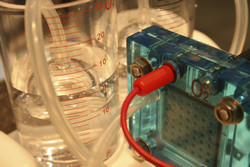Saving up sun for a rainy day
Hydrogen is a clean gas that when fed into fuel cells produces water. Fuel cells operate like batteries to generate electricity through a chemical reaction. There is no combustion involved and therefore, no emissions. Not surprisingly, hydrogen stood out as the energy source that can replace fossil fuels. To date, the production of hydrogen relies on non-renewable routes, like the steam reforming of natural gas. The researchers working on the project COCHALPEC (Development of electrodes based on copper chalcogenide nanocrystals for photoelectrochemical energy conversion) demonstrated an alternative and sustainable route to produce hydrogen. The starting point was the development of solar panels capable of generating an electrical current to split water molecules into oxygen and hydrogen. While the concept is simple, the cost of water-splitting technologies is too high. The COCHALPEC researchers responded to the challenge by devising a new way to build low-cost photo-electrochemical cells. The key to the solution was the adoption of what are known as 2D materials that essentially consist of a single layer of atoms. The COCHALPEC team focused on the synthesis of these materials in the form of nanocrystalline films. Through uniform dispersion in a liquid solvent, tungsten diselenide is transformed into thin flakes. This solution resembling an ink of tungsten diselenide is then injected at the interface between two immiscible liquids, which is used as a 'rolling pin' to shape the flakes into a high-quality thin film. Photoelectrodes fabricated this way were tested and found to be superior in terms of efficiency to thin films made from the same material using other methods. By the end of the COCHALPEC project in May 2015, the conversion efficiency achieved was about 1 %. Although fairly low, this could be further improved to provide higher yields in the future.
Keywords
Solar power, photovoltaic systems, hydrogen, 2D materials, tungsten diselenide

